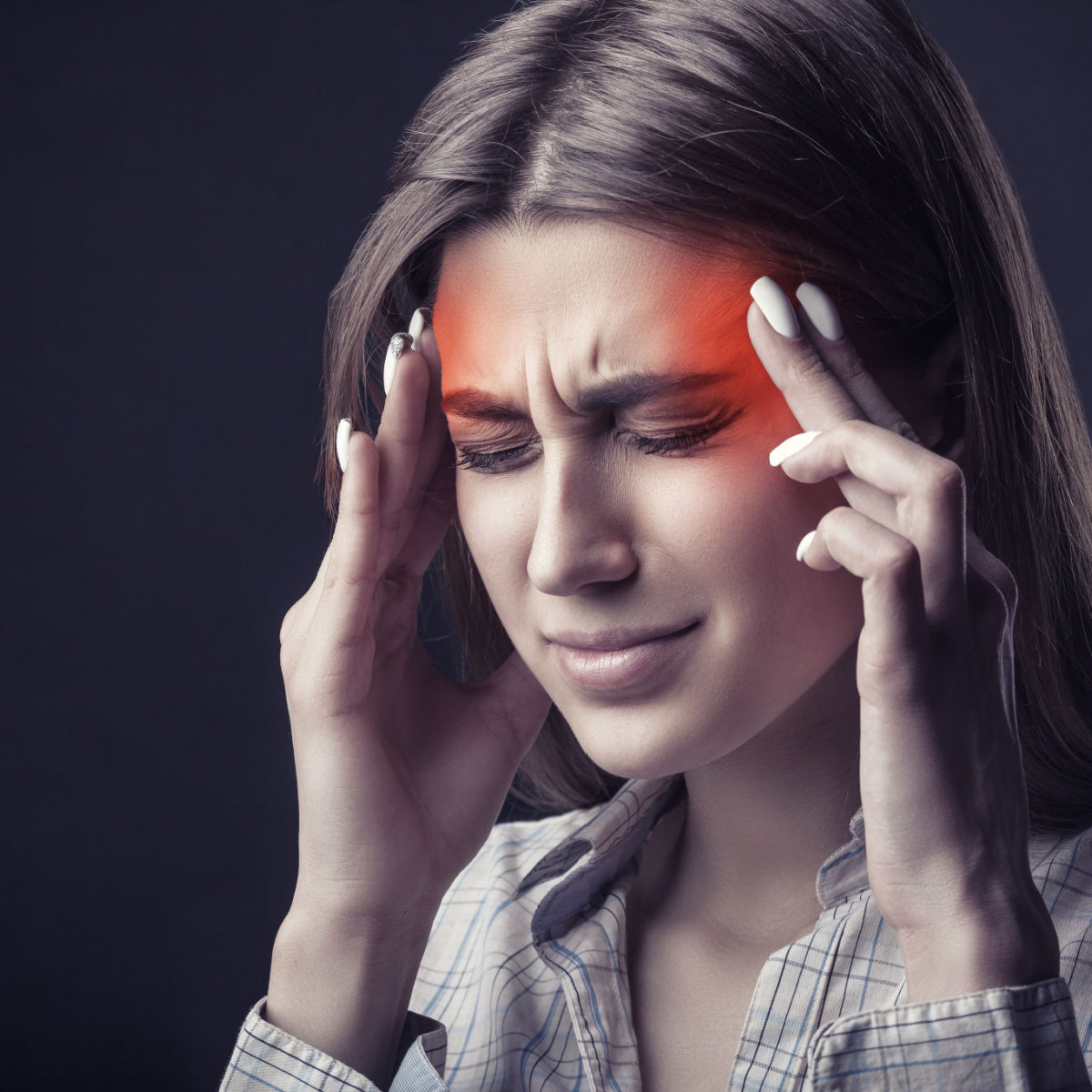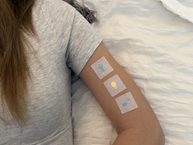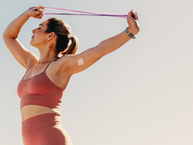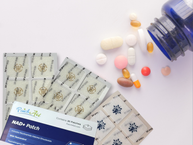What can you do about migraines? Actually, there’s a lot! Migraines can be severe events that can be frequent and debilitating, but they’re not always inevitable. Strategies such as using medications, making lifestyle changes, and trying Migraine Prevention Patch by PatchAid* can be worth trying to see if you can lower the risk of migraines or the severity of the symptoms you have if you do get a migraine.
Migraines are way more than headaches. They can be painful and throbbing, and last for hours or days. During a migraine, you may be unable to follow your usual daily lifestyle. There can be a few stages to a migraine. These are the main parts.
- Prodrome, which can start up to two days before the attack. Symptoms may include constipation, mood changes, a stiff neck, and fluid retention.
- Aura, which happens due to temporary nervous system disruptions and can become noticeable before or during an attack. Symptoms can include vision trouble, numbness in the arms or legs, and trouble moving or sleeping.
- Attack, which is the main part of the migraine. It can include the well-known headache, serious sensitivity to light and sound, and nausea and vomiting.
As an attack comes on or during the full-fledged attack, you might be most interested in what you can do to relieve symptoms. After an attack, you might be in a good position to think about what you can do to prevent one in the future. There are many strategies for doing so, including using a Migraine Prevention Patch by PatchAid.
These are 13 tips for preventing, stopping, or relieving migraines so that they can be less disruptive in your life. Be sure to talk to your healthcare provider if you get migraines and before using any medication or a vitamin patch to address them.
Go somewhere dark and quiet.
This may be the best-known response to a migraine. If you become ultra-sensitive to light, retire to a dark room. You may need to turn off some lights and close some curtains to darken the room. If it’s still not dark enough, you might want to create a dark environment by placing sleeping shades over your eyes. If you don’t have any handy, it can help to place a towel or spare article of clothing over your eyes to block out the light.
Similarly, if you’re extra sensitive to noise, find somewhere quiet to stay until you feel better. Ear plugs can help if you tend to get caught at work, in a home with children, or somewhere else that’s noisy when a migraine happens. They’re easy to carry in a pocket so they can always be available.
The purpose here is to stop what your brain is perceiving as overstimulation. If you can find a comfortable place to relax while blocking out noise and light, so much the better. Letting your senses rest can help you get over a migraine faster than if they are overloaded.
Use heat therapy.
Heat can be comforting during some migraines, and it may help by stimulating blood flow to the affected area due to a temperature change compared to without heat.
A heating pad or warm compress can feel relaxing and may help relieve symptoms. Ask your doctor for instructions on using one, including making sure that it does not burn you.
Use cold therapy.
As with heat, cold therapy works by changing the temperature of the affected part of your body. It may feel especially good if your migraine was triggered by too much sun or if you are feeling warm.
Choose the type of cold therapy that feels best to you. Some people prefer a cold compress, while others like a bag of ice that’s wrapped in a towel. Ask your healthcare provider how to use it. Some people may end up applying it for 10 to 15 minutes once per hour during an attack, for example.
Drink more water.
Staying hydrated on a daily basis is a strategy for preventing migraines or making symptoms less severe. If you’re dehydrated, drinking more water can help make headaches less frequent or severe, or make them last for a shorter time.
Most people need 8 to 10 8-ounce cups of hydrating fluid each day. Other hydrating fluids besides plain water include tea, coffee, and broth. You can also try ice water or water with lemon, strawberry slices, mint leaves, or basil to make it taste better. You’ll need more water if you exercise a lot, are ill, or live in a warm or humid climate.
Identify and avoid triggers.
Often, there are certain triggers that lead to migraines. These might be predictable or regular. If you can identify what your triggers are, you can try to avoid them.
You might want to use a journal to track symptoms and events or circumstances that might have triggered them. You can also note which foods you ate and if anything unusual happened to make you feel a strong emotion. Also note when symptoms come on, whether in the prodrome, aura, or attack, and what the symptoms were.
Common triggers may include these.
- Too much unmanaged stress
- Sleep deprivation
- Excessive hunger
- Unhealthy eating
- Caffeine
- Alcohol consumption
- Strong and unpleasant smells
- Certain medications
Remember that migraines can start early compared to the actual attack, and the symptoms may not seem directly related to migraines. For example, constipation and fluid retention can start a couple of days before the attack, and it’s important to note these symptoms and possible triggers as well.
Act quickly.
It pays to learn your body’s signs that migraine is approaching. That way, you can act quickly when you notice signs. The prodome period of a migraine may include signs such as fatigue, constipation, irritability, and fluid retention. You may have carbohydrate cravings or increased sensitivity to light or sound.
If you have these symptoms and you are someone who is experienced with migraines, you can act on them. You may have medications recommended by your doctor, or you might know from experience that drinking more water, taking a nap, or sitting and relaxing in a dark and quiet room can head off the worst of the attack. You might try a Migraine Relief Patch by PatchAid, assuming your healthcare provider agrees.
Take medication to relieve pain.
For many people, the first instinct when they have a headache is to take a pain relieving medication. Examples include acetaminophen (Excedrin, Tylenol), aspirin, ibuprofen (Advil, Motrin), and naproxen (Aleve).
These and similar medications may be available over the counter and widely used for a variety of common conditions, but it’s still best to ask your doctor before using any medication so you can be sure to use it properly and prevent unintended consequences. You’ll need to know how much to take, when to take it, how long to continue taking it, and whether to take it with food, for example.
These medications can effectively reduce pain, and they can do so relatively quickly. However, it is important to remember that they do not prevent migraines from occurring, and so are more of a treatment than a preventive measure.
Use a Migraine Relief Patch
Some vitamins, minerals, and other compounds may be involved in some of the processes related to migraine development or migraine symptoms. Getting sufficient amounts of key nutrients or other compounds could be useful.
The Migraine Prevention Patch by PatchAid is formulated to include specific compounds that could be related. Essential nutrients include riboflavin, or vitamin B2, as well as vitamin D, magnesium, folic acid, vitamin B6, and vitamin B12. The Migraine Prevention Patch by PatchAid also has butterbur, feverfew extract, and coenzyme Q10.
The vitamins, minerals, and other ingredients in Migraine Prevention Patch by PatchAid may have the following effects.*
- Support normal energy and metabolism.
- Protect cells against damage from harmful oxidation.
- Support normal muscle relaxation.
- Promote normal immune function.
If you are trying to decide between an oral supplement and a vitamin patch, consider the challenges of trying to take a pill while you’re dealing with a migraine. You may be nauseous or exhausted, and not really up to the challenge of trying to choke down pills or timing them with meals.
Using PatchAid patches is so easy to use that it doesn’t cause an extra headache! You can just stick one on a clean and dry area of skin and leave it on for up to eight hours.
Drink coffee.
Coffee is a source of caffeine, and caffeine may help reduce migraines. That’s because caffeine makes blood vessels constrict, which can reduce the pressure in your head. That can lead to less pounding and throbbing pain.
Coffee may be the most common source of caffeine for Americans, but there are many others. Colas and sometimes other soft drinks, energy drinks, green and black tea, and some sports drinks have caffeine. Many migraine medications have caffeine, too.
Still, it’s important to find a balance with caffeine. It is easy to get addicted, which means you are at risk for fatigue and withdrawal headaches if you do. Too much caffeine, or caffeine too close to bedtime, can lead to trouble sleeping, which can trigger migraines. Ask your doctor what a good amount of caffeine might be for you.
Get more sleep.
Being sleep deprived can trigger migraines, so it can help to take a look at your sleep patterns. Most adults need 7 to 9 hours of sleep a night. You might be low on sleep if you are drowsy during the day, if you are sleeping heavily when your alarm clock rings, or if you sleep far past your normal waking time when you have the chance, such as on weekends.
These are some ways to get more quality sleep.
- Turn off TVs, phones and computers at least an hour before bedtime.
- Have a consistent bedtime.
- Go to bed early enough so that you have enough time for adequate sleep before your alarm clock goes off in the morning.
- Eat a lighter dinner to avoid indigestion that can keep you awake.
- Establish a relaxing bedtime routine.
The Sleep Aid Vitamin Patch by PatchAid contains melatonin, which is a natural sleep hormone.*
Manage stress.
Excessive stress can be a trigger for migraines. Sources of stress can include worries about work, finances, or health, having too much to do, relationships, and any number of other things in life. Some ways to manage stress include the following.
- Get regular physical activity.
- Eat a healthy diet.
- Meditate or practice yoga.
- Visualize or use muscle relaxation techniques.
- Journal.
- Phone a friend.
Getting a massage can also help your muscles relax.
Get a night guard.
Excessive tooth grinding can trigger migraines, and many people grind their teeth overnight. A dental guard that you wear at night can prevent tooth damage and possibly migraines. Ask your dentist if you might be grinding your teeth at night. You might get a prescription dental guard, but you can also purchase an inexpensive over-the-counter one and mold it to fit your mouth. Chewing a lot of gum can also trigger migraines.
Use ginger.
Ginger is known for its ability to reduce nausea and vomiting, and that’s important if those are some of your usual migraine symptoms. It turns out that ginger may be able to reduce migraine headaches as well. Fresh ginger, ginger tea, the Nausea Relief Patch by PatchAid, and ginger candies can all contain ginger.
Migraines can really put a damper on things, but there are a lot of ways to try to reduce their impact on your life. Some lifestyle changes, nutritional considerations, and medications could be worth trying. The Migraine Prevention Patch by PatchAid is a simple solution to help promote your efforts.* Be sure to talk to your doctor about migraines and before using any nutritional supplements.
*The Food and Drug Administration has not evaluated these statements. PatchAid patches are not intended to diagnose, treat, cure or prevent any disease. Anyone with a medical condition should seek the advice of a licensed medical practitioner. Individual results may vary.







